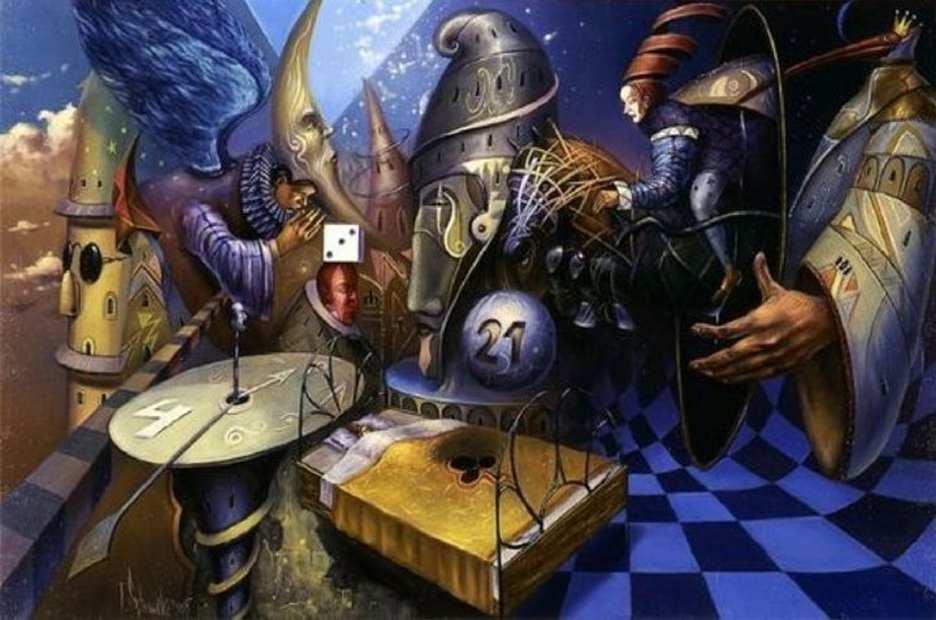
Attack and Defense: Just Two Faces of the Same Coin?
Attack and defense, in chess, warfare, sports, or conflict of any sorts, are they two opposing things? or maybe just a manifestation of the same underlying reality, of a phenomenon that concepts of both attack and defense fail to capture in its entirety? A higher truth that both attack and defense are trying to describe from two different perspectives?
If so, what that enigmatic emerging truth of chess might be?
While dealing with this issue we come to defining, by some, the main principle of chess.
 Tomasz Setowski (Polish), W obronie krolowej (In defense of the Queen)
Tomasz Setowski (Polish), W obronie krolowej (In defense of the Queen)
.
In chess, as in warfare, every problem is a duality. This is inevitable consequence of things being a two-party affair. For example, while hitting, one must guard.
All chess rules assume a dualistic formulation. A weak square in the opponent's camp may become a strong outpost for your men to exploit. By every move you make your pieces take control over certain complex of squares while at the same time they are losing command over others. From "don't weaken your king's cover" comes "create holes in the other King's position," etc.
.
DUALITY of WESTERN SCIENCE and EASTERN PHILOSOPHY
What is duality anyway? The term comes from physics. Basically, it gives two different points of view of looking at the same object. It is not what it means in everyday language, typically two-valued black and white, true or false. The physicist’s view on duality is that two very different things may be equally true. The truth seems to be like a “third way”, far more complex route to perceive and unravel the hidden higher reality (Amanda Gefter).
In western science, duality can mean either existing in one of two forms apparently unrelated to each other, yet having the same physical content (e.g. wave or particle, in quantum mechanics), or being interchangeable (e.g. points and planes, in geometry). In a dualistic world, there is reciprocity (mutuality) of things, like action and reaction as per Newton’s third law of motion. There is also parallelism (analogy) that exists between different (chess) laws which is suggestive of the underlying unity of these laws.
 Duality of Western science and Eastern philosophy shown here as yin and yang
Duality of Western science and Eastern philosophy shown here as yin and yang
Eastern philosophy also recognizes the dual nature of reality where yin and yang are an expression of this duality. Enlightenment (English term used to translate several Buddhist concepts) represents a concept of wholeness, or balance. The oscillation in the duality is balanced, not biased on one side or the other. Things are operating at the midpoint in the swing between yin and yang, from positive to negative pole (note that ‘negative’ is not bad, it is just the mirror-image of ‘positive’).
“Be in truth eternal, beyond earthly opposites”, –Bhagwat Gita
The world around us is riddled with dualities. Here are some examples from different domains,

Table showing dual partners in various domains (source: A. N. Mitra, Duality, a bridge between Physics and Philosophy? 2008)
.
 Duality (credit: Pinacoteca Central)
Duality (credit: Pinacoteca Central)
.
THE MAIN CHESS PRINCIPLE
Chess battle is therefore a balance between attack and defense, the active and reactive forces on the board. Both attack and defense use the same striking force of chessmen. It is just a matter of the player's style which element in the duality they pay more attention to. Being Tal, or Petro.
.
We are now ready to define what seems to be the main principle which is, ACTIVITY (a),
At the same time (as the principle of duality explained above suggests), you have to constantly slow, restrict, or neutralize the activity (and mobility) of the opponent's army (b).
The statements (a) and (b) provide an integrated, dualistic view of the chess Space-Time continuum. They are also revealing that you can improve board position either by using (a), or (b).
[The same above definition (a) from which stems (b) can be found in Dydyshko's Logic of Modern Chess. Karpov and Matsukevich's main principle in Find the Right Plan with Anatoly Karpov is "restriction of the mobility of opponent's pieces", that is Part (b) above out of which, according to the authors, flows Part (a). For Capablanca, the main principle throughout is coordination of pieces (in an upcoming post we will discuss the connection between the principle given here and the one by Capablanca).]
.
 a Tomek Setowski art
a Tomek Setowski art
.
Some reactive measures that belong to Part (b) of the main principle may be as follows (I don't like the term "defensive" as any effective defense can only be active - a passive defense is just a sure way to a slow death),
1) trade the dominant enemy pieces, or prevent their becoming too active (see an example below from Petrosian games),
2) create disruption in the way the opponent's pieces coordinate their action,
3) launch a counterattack in the center or the opposing wing to distract and deflect the opponent's attack on your king's position, etc.
[You] must maintain an adequate defense, and advance under cover of this defense and maneuver your opponent into a position where his defense can be penetrated and an attack can be mounted to knock him out. In military terms, objective (think), security (guard), mobility (move), striking power (hit). –J.F.C. Fuller, the British strategist
As you can see, attack and defense are not separate entities. They are just two faces of the same coin. It is like a wrestling match where two contenders are in a tight grip each trying to control the opponent and advance in positioning in order to gain advantage and maintain/regain domination. If both sides are trying to be active, what is then the differentiating factor in the grapple? It is who is possessing initiative.
Again, there is no activity without considering the active plan of the opponent. This has been known in warfare for at least twenty-five centuries.
The best strategy is to fight the enemy's strategy. –Sun Tzu
 Tomasz Setowski, Krolestwo (The Kingdom)
Tomasz Setowski, Krolestwo (The Kingdom)
.
Nimzovich's ideas of the blockade and prophylaxis were actually introducing into chess the second, that is Part (b) of the main principle, already known in warfare for more than two millennia.
When asked to nominate his best game, Nimzovich replied, "the one I played in the 1962 Dresden Tournament against Rubinstein. I don't know any other of my important games which so well illustrates the principle of effective hindrance of the adversary’s forces, while at the same time securing the mobility of one’s own forces." The highlight reads the main principle only in different words.
.
MAIN PRINCIPLE IN PRAXIS
The following game is a manifest of an ideal as far as the activity is concerned. Petrosian first curbs all activity by Spassky on the Q-side, and then initiates active operations on the opposing wing. Great pawn play by Petro as well.
Follows an epic defense by Keres against one of the greatest attackers in the history of chess. Having won a pawn and destroyed the opponent's King's cover, Tal finds himself in a sort of impasse while Keres is activating his men to draw his trumps.
In the next game, it is not the most active enemy piece, it is the piece that MAY become the most dominating and critical one to possessor's defenses. Petro stops that from happening.
.
How many good moves and games of yours have been thrown down the drain because you neglected and failed to see the opponent's intents and threats? Your moves should not only aim at just improving position of your men, but also preventing your opponent from activating/improving position of their own.
This should become one of the most cherished habits of your chess mind.
.
.
